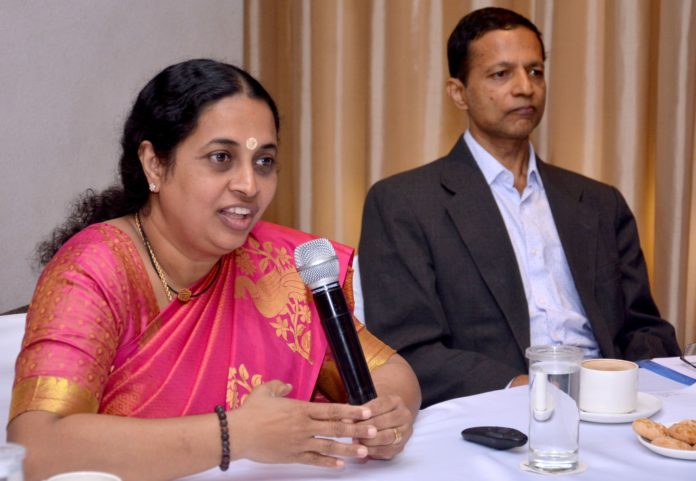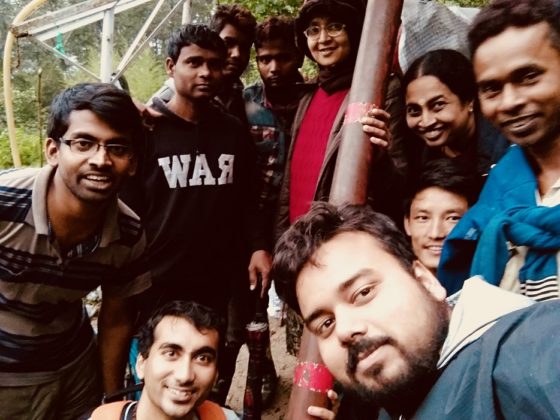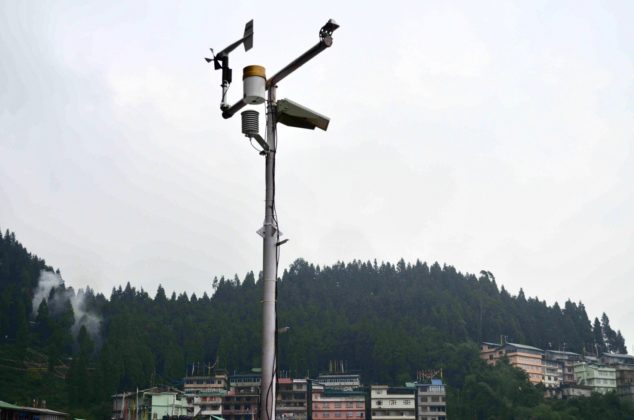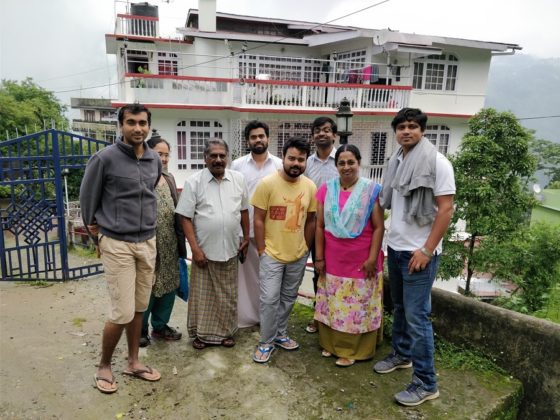Amrita’s real-time landslide warning system to save lives in Himalayan region
- The Sikkim-Darjeeling belt is among the world’s most prominent“landslide hotspots”
- The deployment in Sikkim will be the second one in India by Amrita Vishwa Vidyapeetham. Its first system in Kerala’s Munnar district has issued several successful warnings till date
- The project is co-funded by Ministry of Earth Sciences, Govt. of India
- The in-situ wireless sensors-based system developed by Amrita is considered much more accurate than the rainfall threshold model used worldwide. It is a real-world IoT (Internet of Things) system for effective Landslide Early Warning
August 1, 2018 / KOLKATA –Amrita Vishwa Vidyapeetham – ranked India’s eight best university in the 2018 NIRF rankings– is on a mission to save lives in mountainous regions by installing systems that give advance warnings of landslides that people can be safely evacuated before disaster strikes. After successfully commissioning India’s first such system in Kerala’s the Western Ghats, it is now readying the second installation in Sikkim to guard against rainfall-induced landslides in the Sikkim-Darjeeling belt.The project is jointly funded by the Ministry of Earth Sciences, Govt. of India, and Amrita Vishwa Vidyapeetham.
Dr. Maneesha Sudheer, Director, Center for Wireless Networks &Applications, Amrita Vishwa Vidyapeetham, who spearheads landslide research at the university, said: “Landslides are the third most deadly natural disasters on earth, killing over 300 people every year globally. The number of fatal landslides in India is higher compared to other countries. A report by Indian Roads Congress estimates that 15% of India’s landmass is prone to landslide hazard, including areas like the Western Ghats and Konkan Hills, Eastern Ghats, North East Himalayas, and North West Himalayas. In North East Himalayas, the Sikkim-Darjeeling belt is at the most risk of landslides, which is why we chose this area to install our landslide detection system.”
As per David Petley’s global database on landslides, the world’s top two landslide hotspots exist in India: the southern edge of the Himalayan arc, and the coast along south-west India where the Western Ghats are situated. Not only is tectonic activity higher in the southern Himalayan arc, monsoon rains and manmade changes to the slopes have made these hills much more prone to landslides.
Said Dr.Venkat Rangan, Vice Chancellor, Amrita Vishwa Vidyapeetham:“Under the direct guidance of our Chancellor, Sri. Mata Amritanandamayi Devi, Amrita Vishwa Vidyapeetham deployed a unique system in Western Ghats in 2009 in Kerala’s Munnar district, with the noble objective of saving human lives. This system has been actively monitoring the area for landslides and has issued several successful warnings to date. Impressed by this success story, the Govt. of India approached Amrita to develop a similar system for the Sikkim-Darjeeling region which is very active geologically and is vulnerable to rainfall-induced landslides. Accordingly, we have deployed this new system in collaboration with the Sikkim State Disaster Management Authority and are being co-funded by the Ministry of Earth Sciences, Govt. of India.”
Amrita’s new IoT (Internet of Things) system for landslides, being installed in Sikkim, is custom developed for Himalayan geology. It consists of over 200 sensors which can measure geophysical and hydrological parameters like rainfall, pore pressure and seismic activity. It will monitor a densely populated area spanning 150 acres around the Chandmari Village in Sikkim’s Gangtok District. This area has seen landslides in the past, the first one being reported in 1997.
The system collects real-time, continuous data from the sensors, performs basic analysis at the Field Management Center (FMC) located on the site in Sikkim, and relays it to the Data Management Center (DMC) at Amrita Vishwa Vidyapeetham in Kerala’s Kollam district. The university researchers are using this data to characterize and learn the geological and hydrological nature and response of the hill with respect to the dynamic and real-time meteorological variations to develop the Landslide Early Warning Model for that area.
To improve the system’s reliability and enhance the early warning duration, a three-level Landslide Early Warning Model has been developed. The first level, based on rainfall threshold, has successfully completed the testing phase and is ready to go live and issue alerts for potential landslides at the state level. In the second level, the system would generate a Factor of Safety (FOS) value for various points on the hill in real-time that will provide a more specific warning for the Chandmari region based on the rainfall, moisture and pore pressure sensor data from the field.In the third level, the system would use data derived from the movement and vibrational sensors to issue landslide detection warning.
Said Dr. Maneesha Sudheer:“This multi-level warning system will help disaster management authorities to take steps to mitigate and manage potential landslide threats in a proactive and effective manner. In this regard,Amrita has performed several community engagement programs to disseminate knowledge regarding the impact of the landslides, the working of the proposed warning system and its capability to warn about imminent landslides.”Added Dr.Venkat Rangan:“This project shows Amrita’s commitment to serve the world, the vision derived from our Chancellor. For inculcating this vision in the faculty and student community, Amrita University has integrated several unique initiatives for the natural fusion of multiple disciplines leading to the delivery of an affordable solution for saving human lives. Indian higher education has to be geared in this direction to solve the pressing needs of the world.”
Landslides can be triggered by natural causes like vibrations from earthquakes and the build-up of water pressure between soil layers due to prolonged rainfall or seepage. In recent decades, manmade causes have become significant in triggering landslides, including removal of vegetation from the slopes, interference with natural drainage, leaking water or sewer pipes, modification of slopes by construction of roads, railways, buildings, etc., overloading slopes, and vibrations from traffic. “Even though many factors contribute to making a slope vulnerable to landslides, major triggering factors are rainfall and earthquake. Areas of steep slopes, those having tectonic activity and hilly terrains with heavy rainfall are at great risk of landslides,” said Dr. Maneesha Sudheer.
Talking about how accurately can landslides be estimated using technology, she added: “Landslides can be estimated at different accuracy levels through rainfall threshold based models, in-situ sensor-based monitoring technology, Interferometric Synthetic Aperture Radar (InSAR) based technology, ground-based radar technology, Electrical Resistivity Tomography (ERT) and satellite images. Rainfall threshold based models are most commonly used in the world and have issued several early warnings, but with more false-positives than accurate predictions. In-situ monitoring methods (deployed on the ground) like what we are setting up in Sikkim can issue early warnings much more accurately than the rainfall threshold model. The landslide monitoring system installed by us in Munnarhas issued several successful early warnings till now.” Unfortunately, the landslide-warning system being installed by Amrita researchers in Sikkimwas severely vandalised by miscreants in April this year. This laid waste to two years of field work by the scientists, forcing them to start all over again.
According to Dr. Maneesha Sudheer, several steps can be taken to reduce fatalities due to landslides. “In the case of landslides, forewarned is forearmed. More accurate landslide databases need to be maintained and regional as well as site-specific rainfall threshold models developed. Low-cost in-situ monitoring technologies have to be deployed in landslide-prone terrains. People have to be educated regarding landslides and the risks involved. Social media and mobile phone apps can be developed to collect data about the chances or precursors for landslides from the people and other governmental organizations,” she said.
Amrita Vishwa Vidyapeetham’sCenter for Wireless Networks & Applications has also initiated a landslide-research project with the British Geological Society and the UK Met Office to develop regional thresholds for landslide warning in the Sikkim-Darjeeling belt and Western Ghats.
In 2008, Amrita University set up India’s first landslide laboratory which serves as a test bed for development and validation of systems deployed in landslide-prone areas. It can create small landslides under controlled conditions and act as a feedback system for field deployment. The university pioneered the wireless sensor-based system for detection of landslides that is more accurate than the rainfall threshold model. It was awarded the ‘World Center of Excellence on Landslide Disaster Reduction’ in 2017 by the World Landslide Forum.
About AMRITA VISHWA VIDYAPEETHAM (AMRITA UNIVERSITY)
Amrita Vishwa Vidyapeetham is a multi-campus, multi-disciplinary research institution that has been ranked
among the best Universities in India by NIRF, Times Higher Education, QS, etc. The 2018 NIRF Ranking has judged it the eighth best university in India. Amrita Vishwa Vidyapeetham is spread across six campuses in Kerala, Tamil Nadu, Karnataka, and Haryana (coming soon) with headquarters at Coimbatore. It has more than 18,000 students, more than 1,800 faculty, more than 200 academic programmes, 5200+ Scopus-indexed publications, 33,000 citations and Rs 250 crores in research funding.
World-renowned humanitarian and spiritual leader, Sri Mata Amritanandamayi Devi, is the founder and Chancellor who has encouraged the university’s R&D departments to focus on developing technologies for uplifting the poor and the needy. In the past few years, Amrita Vishwa Vidyapeetham has become known for its work in gender equality, disaster management and sanitation outreach.


































